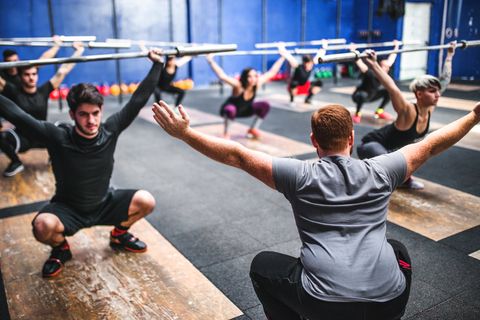
Group fitness classes are becoming more popular — and that means that in just about every HIIT burner or spin session, there’s a good chance there’s at least one newbie with no idea what they’re supposed to do.
Trying a new workout is always a great way to shake up a stale routine, but whether someone is just learning a laid back yoga flow or an intense CrossFit WOD, first-timers can be more likely to hurt themselves due to their inexperience. That’s why it’s so important for the instructor to guide new clients properly, offering the right amount of encouragement and direction to show them the ropes.
We talked to two veteran trainers about their techniques for bringing first-time group fitness attendees into the fold. If you want to check out a class, make sure that you and your instructor take these steps. If you’re a coach, use these tips to keep new people safe, giving them an awesome workout that will make them want to become a regular.
Get All the Info You Can
Getty Imagesfreemixer
First things first: make it a point to actually meet each other.
“It is important to get to know your clients prior to the beginning of the class,” says Rebecca Gahan, CPT, owner and founder of Kick@55 Fitness, a HIIT studio in Chicago. “Ideally, if there is time, a client intake form should be filled out and reviewed by the instructor before class.”
Here, new people can list previous injuries and conditions. If there’s no time for a form, instructors should ask new clients before class begins if they have pre-existing conditions or require modifications for certain exercises, Gahan says.
It’s also smart to tell new clients about exercises that could be problematic for the uninitiated (i.e. deadlifts, box jumps, or pull-ups). “If the client says they have knee issues, the instructor should provide them with non-plyometric movements throughout class,” says Gahan. This gives new people another option. “For example, lunge jumps can be modified to alternating reverse lunges and tuck jumps can be modified to high knees.”
This disclosure isn’t just the instructor’s responsibility. If you’re taking a barbell class for the first time but you have shoulder issues, for instance, you need to speak up before you spend the whole session skipping moves — or worse, getting hurt.
Make Sure Everyone Is Prepared Throughout Class
You’ll want to keep class participants, especially beginners, in-the-know about the workout.
“A coach must be thinking two or three steps ahead of class participants in terms of the layout of the space, the equipment that they’ll need,”says Todd Nief, CSCS, owner and founder of South Loop Strength & Conditioning in Chicago. “The coach must communicate to people in a clear way where they are to set up, what they’ll need, and when they’re supposed to be doing things. By setting this up and preparing for the next piece of class preemptively, coaches can ensure that class logistics are under control, which sets members up to have a good experience.”
Newbies should, again, make sure to ask questions. If the class set-up is confusing, don’t just copy the person next to you — confidently get the instructor’s attention (after they explain everything for the rest of the group, of course), then request some clarification.
Keep an Eye On the Room
Getty ImagesHero Images
Instructors should be keeping an eagle eye on everyone to spot improper form or signs of injury or excess fatigue, says Gahan, giving special attention in particular to newcomers. A tip from Gahan: moves like Romanian Deadlifts and Kettlebell Swings are common injury-prone exercises, since the form can be difficult to master.
If the class is on the larger scale and it’s challenging to view everyone’s performance, it’s OK to ask your regulars for some help. “We have identified alumni in class who have stellar form and love to help new people,” says Gahan. “These individuals are paired with new people to help them select the proper equipment, navigate through exercises, and address form/technique.”
Ideally the instructor should be correcting form, but in busy classes, Gahan has found that this is a good alternative. Another option is to have people in the class monitor each other in groups, especially on the more challenging moves.
Newcomers to classes should check their pride at the studio door. If an instructor asks a more experienced member of the class to give you a helping hand, suck up your ego and listen to their form checks and advice.
Give the Right Advice — and Be Ready to Take It
A drill sergeant’s demeanor can be intimidating for new people in a workout class — and it’s already tough enough for some people to try their first box jump in front of a room full of regulars. Coaches should make sure to temper their authority with some compassion. Just remember what it was like the first time you tried the workout.
“Even when class members are doing something unsafe or with poor form or improper pacing, they don’t always like being told to slow down, reduce the weight they’re using, or keep their backs straight,” says Nief. “A great coach can quickly deliver feedback in a firm but non-confrontational way that makes class participants eager to change what they’re doing.”
If you’re in the class for the first time, remember one thing above all else: the instructor wants you to have a good time. Even if they sound tough, they’re doing their best to motivate you to make the most of your workout. That way, you’ll be eager and willing to join them again for a second session.
Source: Read Full Article

